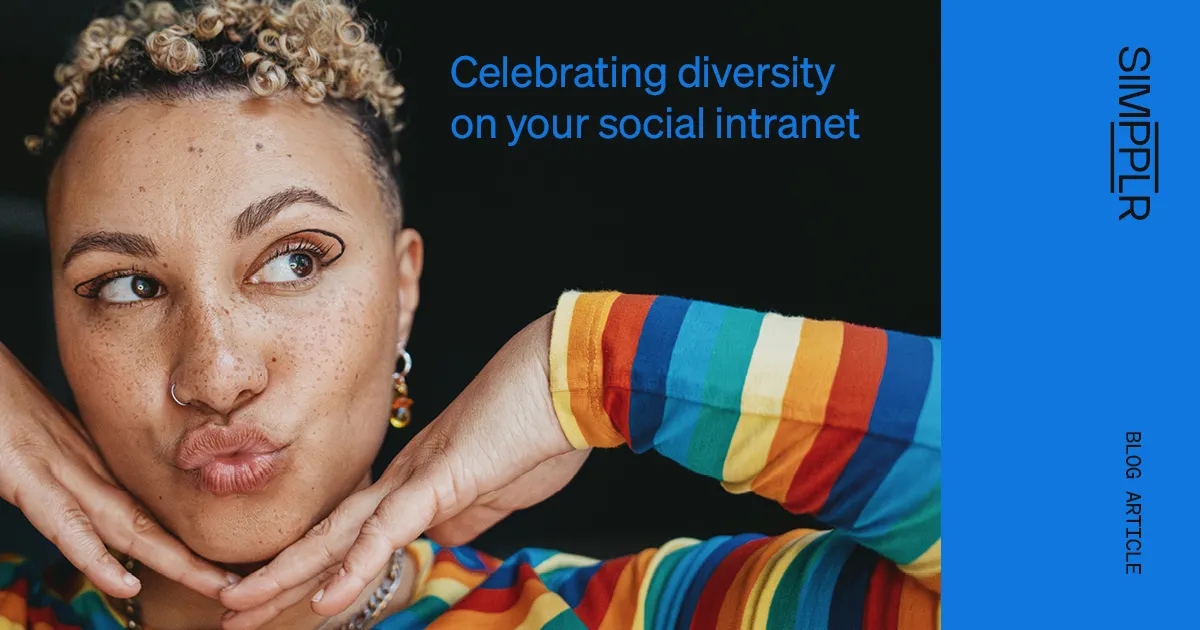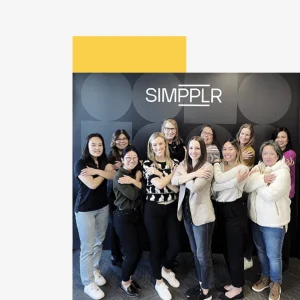If the importance of diversity in the workplace is in any doubt, consider that, by 2055, the USA will no longer have a single racial or ethnic majority. This is according to a study by the PEW Research Center on demographic trends shaping the world. This indicates that organizations ahead of the curve on diversity and inclusion issues will have a competitive advantage going into the future. And as we come to the end of Black History Month, what better time to reflect on these efforts and its impact on the workplace?
Merely recognizing diversity isn’t enough, however. In this guide, we’ll take an in-depth look at the concept of diversity and what benefits to expect when diversity is embraced in the workplace. We’ll also look at how to create diversity strategies and the challenges. We’ll discuss training options and the benefits of those, plus how to improve the employee experience through diversity and inclusion. Lastly, we’ll include some case studies so you can see where the implementation of effective diversity strategies has been successful.
The concept of diversity in the workplace
Before we start, let’s look at how we often see the words ‘diversity,’ ‘equity,’ ‘equality,’ and ‘inclusion’ frequently interchanged and often abbreviated to DEI. Remember, these words are not synonymous. ‘Diversity’ is a comprehensive concept that refers to a diverse group of people with different experiences and origins. ‘Equality’ and ‘inclusion’ are different.
Diversity can be defined as the state of being diverse, and it goes hand-in-hand with inclusion in the workplace. And to be authentic, it is essential to ponder all the parts of diversity, and how it comes to bear in our workplaces and the world around us—and organizations must embrace as many diverse elements as they can identify.
The dimensions making up the concept of diversity are many, and, though difficult to pinpoint, they include age, gender, race and ethnicity, sexual orientation, physical and mental ability, attributes, education, socioeconomic status, military service, parental status, and language. Add religious and ethical values, political beliefs, and national origin to this list, and you’ll begin to form a picture of the vast scope of elements that make up the concept.
The United Nations recognizes more than 30 characteristics within diversity, but there are many more. Some are visible, some not. Some are unchangeable parts of who we are, while others may change over the course of a lifetime.
Diversity in the workplace: four types to consider
Internal diversity
Internal diversity includes traits or characteristics with which a person is born and can consist of race, sex, ethnicity, gender, sexual orientation, nationality, physical or mental ability, and others. Many of these are recognized as protected characteristics under the United Nation’s Universal Declaration of Human Rights.
External diversity
External diversity is so-called because it can be influenced or changed by others. This covers any circumstance, experience, or attribute that helps identify things like a person’s education, marital status, socioeconomic status, or religion.
Organizational diversity
Organizational diversity covers differences in work experiences, job functions, departments, management level, and seniority.
Worldview diversity
Worldview diversity includes all the factors that influence how a person sees the world contributing to worldview diversity, and has various beliefs, political affiliations, and cultural and travel experiences.

Benefits of diversity in the workplace
Vast scope means vast potential, which is a massive benefit of diversity. Other benefits include increased creativity and innovation, improved decision-making, enhanced problem-solving abilities, better communication, and a more positive organizational culture across all company levels.
Increased creativity and innovation
In today’s business world, prospective employees actively seek employment within diverse work environments. Because a diverse workforce brings a broader range of skill sets, better ideas will present themselves. New and different perspectives energize creativity and innovation. It follows that companies leading the field in diversity strategies will be able to attract and retain top talent.
Decision making
Decision-making in a diverse group prevents ‘groupthink.’ No surprise, then, to learn that groupthink happens when team members think the same and are the same. Decisions might be made swiftly, but are they the best ones decided after all options have been thrashed out? Probably not. A diverse team brings unique skills, knowledge, etiquette, and behaviors to the table, allowing issues to be approached innovatively. Getting out of your comfort zone and casting the net wider where decision-making is concerned is essential.
Problem-solving
In a similar vein, solving problems with the help of a diverse group works better because all angles are covered, all processes considered, and, more than likely, several solutions are made possible. Thinking outside the box is a norm in a diverse workplace, which is enormously beneficial in problem-solving. Open minds and wide acceptance allows access to a broader talent pool.
Diverse teams produce better leaders.
A widely diverse team presents a big challenge for a new leader. She’ll have to think on her feet and adapt quickly.
Increased awareness and knowledge
By working and mixing in a diverse environment, employees can appreciate new knowledge, awareness, and tolerance around numerous cultural, ethical, sexual, and other issues. This positively influences the company culture and can also be carried beyond the organization to customers and into the lives of everybody beyond work.
Challenges of creating a diverse workforce
Introducing diversity strategies in the workplace will be futile without essential commitment and effort on all company levels. Integration in a multicultural arena can be complex. Still, unless fostered throughout every section, group, and department, colleagues may find it more comfortable to work in isolation, preventing the transfer of skills and knowledge.
Unconscious bias or underlying prejudices can be difficult to pinpoint, but they must be addressed because cultures harboring these don’t work well. Outright prejudice is a serious problem.
If stereotyping occurs, and it is often deep-rooted, it can be limiting and divisive and lower morale and productivity.
It’s worth noting that different cultures have their own formalities, organizational hierarchies, and behaviors, and while this is inspiring in the workplace, it can also lead to misunderstandings.
How do we overcome resistance to change?
It’s important to expect resistance and, problematic as it is, to respect the reasons for that resistance. That said, while diversity in the workplace generally stimulates creativity and innovation, some unfamiliar approaches can make the path to achievement difficult to navigate. Some team members prefer a collaborative ‘all in’ process, while others prefer individual input. Some workers will favor methodical order, and others will prefer something more flexible and spontaneous.
Training can be offered to help individuals, teams, and their leaders move closer to an inclusive, collaborative process. With training, leaders can learn to plan effectively, and although a diversity strategy is an ongoing process, make every effort to do it right the first time. Learning about clear communication and how to listen, accept and use feedback is also essential. If the concept of diversity and integration is new to your workplace, people will need channels of communication open for support.
Implement change steadily and communicate effectively around this using a modern intranet specific to your requirements. And remember, it’s vital to retain a flexible attitude around different working styles.
How to provide the necessary support
What methods of support and resources are required to create an inclusive culture? Don’t just talk the talk. Provide up-to-date support and resources to implement the best diversity strategies for your company so you can walk the walk too.
- Provide safe spaces, especially for marginalized individuals and groups.
- Enable equal access to company knowledge.
- Share cultural knowledge and encourage exchanges.
- Open communication around bias and how to identify and manage it.
- Mix up teams. Keeping cultures separate isn’t the point.
- Level the playing field with equal pay.
- Offer diversity tracking and clarify why and what it will achieve.
- Create Employee Resource Groups (ERGs) to grow and develop talent and to build a culture of belonging and connection.
- Review company policies regularly to make sure they align with diversity strategy.
Creating a diverse and inclusive workspace
An enlightened approach to recruitment and hiring is critical
- Make hiring diverse candidates a priority. If your recruitment agency is stuck in a rut, find someone new. Go for somebody who specializes in placing diverse talent.
- Be sure your company brand embraces and reflects diversity.
- Look in new spaces and places to find prospective employees from diverse backgrounds. Make different connections wherever possible.
- Ensure the job description is created to open up all possibilities to attract a wide variety of talent.
- Plan the interview and stick to that plan. You might suffer from unconscious bias, so be aware of that and don’t waver during the interview.
- Blind hiring is worth considering though it’s not for everyone. This process hides all information about the candidate that could negatively influence a hiring decision. This prevents unfair and sometimes illegal judgment.
- Retain talented, diverse employees by fostering a culture where everyone can thrive.
- Boring as it sounds, correct documentation and meticulous management are vital in a diverse workplace.
- Ensure that hiring diverse employees is recognized as a critical element of effective diversity management policy and practice.
Diversity data is vital to reveal trends
Diversity data has an important function with regard to trends. Simply put, it is a list of your workforce’s protected characteristics. This can include gender identity, race, ethnicity, and others, and it is usually anonymous. Analysis of diversity data can indicate how representative you are, which are the minority groups, and who is under-represented. Progress tracking is also possible and shows whether and where the action is needed.
Diversity and inclusion training and development options for employees
Training helps us to understand the fundamental values within a system where equality, diversity, and inclusion are prioritized. We learn about different types of discrimination, how to identify bias, and how to recognize privilege. In addition, we find out how to best constructively confront or avoid issues and how to lead a diversity initiative by example.
Basic training includes:
Awareness training
This is the first step to bringing change to your company culture. It provides employees with an outline of workplace demographics and education around race, ethnicity, minorities, gender, sexual orientation, and others and fosters awareness of workplace equity.
Skills-based diversity training
Once awareness of diversity has been established, skills-based training can be introduced. This ensures that all employees are equipped with skills to promote and participate in all aspects of diversity within the workplace. This enhances feelings of belonging and inclusion. For example, a skills-based training session could focus on communication, allowing employees to gain the skills necessary to foster a culture of diversity within the company.
Diversity audits
These allow you to understand where you started and where you are going. They provide regular checkpoints to assess co-worker relationships, manage employee attitudes, identify discrimination, and encourage employee transparency. At the same time, feedback from employees in a safe space can also contribute to impactful change.
Basic diversity training
This training has a single goal: to create empathy and respect in the workplace. Topics include identifying company values and how diversity and inclusivity embody these, anti-racism training, anti-sexism training, education around gender identification and sexual orientation, cultural sensitivity, and HR compliance.
It’s essential to be realistic when setting goals during training. Clear and comprehensive communication is necessary, and employees must be equipped with the right tools and have access to the resources required to learn how to achieve these goals. Consistently measure progress to see how everyone is getting along.
During training, you will likely have to evacuate your comfort zone. Take courage and have hard conversations because true diversity in the workplace means everybody is in the room.
The importance of developing an inclusive culture through effective communication and leadership
Unbiased internal communications are essential and will go a long way to fostering an inclusive organizational culture. A diverse team where effective communication to and from leaders is practiced will grow from strength to strength. Here are some valuable communication tips:
- Take time to consider your beliefs. Do they affect your tone? Do you communicate more often and more easily with employees of, say, a similar age, race, or gender? Develop awareness as you communicate of your own habits and assumptions.
- Appreciate differences, and let them be known. Differences are interesting and must be valued and celebrated.
- Request, understand, and consider different perspectives within the company process. Honor and respect cultural and religious choices. Be aware of significant events, like Black History Month, and communicate around these. Make sure no one is left out or misses a company event by using your intranet to learn how to create and share a diversity calendar
- Listen to yourself too. When speaking to colleagues, is everyone in the room comfortable? Are you being understood by relating appropriately to younger or older employees?
- Think before you speak or send a message. Avoid jargon, buzzwords, slang, idioms, and anecdotes that don’t relate across cultures or age groups or whose meaning is lost on your co-workers. Not understanding these things can embody a feeling of exclusion. Be aware of language barriers, and always try to communicate equally and clearly.
- Most importantly, perhaps, is to communicate the meaning of ‘zero tolerance.’ Get help adapting policy if necessary, and ensure boundaries are clearly defined for employees and customers. Lean on employees, managers, leadership, IT, HR, and the legal department for input and support. Unfortunately, the list of crimes that may not be tolerated is long and includes verbal and physical harassment of any type, sexual and racial abuse, stalking, intimidation…it goes on. However, it is essential to clarify everything that belongs on that list and include it in your zero-tolerance policy because a zero-tolerance policy provides a safe space for employees, enabling them to feel seen, heard, and valued. This enhances the employee experience, which benefits employee engagement and boosts morale.
Improving the employee experience through diversity and inclusion
The employee experience can be significantly enhanced through diversity and inclusion, where employees can express their full potential regardless of circumstances. Employees feel valued and supported as individuals. Their trust underpins transparency and loyalty, across the workforce, including leaders and management.
Diversity encourages new perspectives from a broad spectrum of talent—greater creativity and innovation spring from this collaboration, resulting in a positive employee experience. Consequently, employee engagement is heightened, and this drives productivity toward a healthy bottom line.
A company’s reputation is enhanced, and its ability widened by a diversity strategy because varied experiences enable a clearer picture and understanding of customer needs.
Education around harmful practices and prejudice teaches valuable life lessons. Not only do they benefit the company on every level, but they resonate far and wide beyond the company itself.
How to create an inclusive and welcoming work environment
- Use inclusive language. If uncertain, ask. If you make a mistake, apologize.
- Put yourself in a colleague’s shoes, preferably a co-worker from a minority group, and think hard about what you learn.
- Create safe places, especially for under-represented individuals and groups.
- Encourage open communication and listen to feedback.
- Develop a company events and holiday calendar and include everyone’s interests. Create and support events and initiatives focusing on diversity.
- Develop inclusive recruitment strategies.
- Provide diversity training, and include leaders.
- Appoint a training group to develop and sustain changes brought about by training.
- Promote a non-discriminatory policy within the company and to customers.
- Establish ERGs to improve the employee experience.
- Create mentorship programs to mentor cross-culture engagement
- Recognize and reward quality performance on all levels equally.
- Get leaders on board, be present, and participate.
- Celebrate differences and build a better workplace where everybody can flourish.
Encouraging employee activism with DEI initiatives
Diversity brings new ideas, and different affiliations to the workspace, and along with that comes attitudes toward political and social issues of the day. Within the bounds of legality, these need to be understood and respected, even if it means agreeing to disagree, even if the disagreement lies with company policy or loyalties.
It’s critical to remain open-minded, to listen and hear, and to keep communication lines open at all times. Employee activism can be a conundrum, where values stand in opposition, so educating yourself on the issues and asking questions is essential.
Someone who is happily integrated into a global oil company might be a member ofJust Stop Oil. Never mind that guy in Marketing who’s always banging on about climate change yet drives a V8.
In a diverse work environment, make space for activism. Employees want the freedom to speak out and for employers to back them wherever possible. You don’t have to take up arms, but get involved the best way you can. Find out about union work, walkouts, and protests, sign that petition, and donate to charity. We don’t all practice what we preach, so open-mindedness, acceptance, and tolerance are key.
Diversity in the workplace examples
- BAE Systems, a multi-national arms, security, and aerospace company
BAE Systems values diversity because it benefits employees and drives growth. To support diversity and inclusion within the company, an additional route into the summer internship program was introduced specifically for individuals who are female or of black, Asian, or minority ethnic group descent.
- Lenovo Group Ltd, a multi-national technology company
Lenovo’s case study of a global program to include diversity proves that progress toward a more diverse and inclusive work environment is achievable for companies wanting to make a difference.
- Ernst and Young Global, multi-national professional services partnership.
Ernst and Young wanted to accelerate the pace of change with regard to gender and racial diversity and to equip managers with the tools and confidence to communicate openly about race and ethnicity in the workplace.
Conclusion
Diversity in the workplace is crucial because it helps ensure relevance in a competitive and ever-changing world. A company with strong diversity and inclusion strategies will attract top talent. Diversity strategies also foster trust and, therefore, loyalty, and this paves the way to a positive employee experience, better employee engagement, and higher employee retention rates, all of which benefit the company.
Don’t let fear of the unknown hold you or your career back. Be part of the change toward a new, tolerant world. Teach and learn, get leaders on board, be present, and get involved. As the saying, often attributed to Mahatma Gandhi, goes, ‘Be the change you want to see in the world.’
Why wait for competitors to progress? Use the leading AI-driven platform offered by Simpplr to support you and your company with relevant and appropriate diversity initiatives. Request a demo to learn how Simpplr can help you connect, inspire and engage your workforce.



















